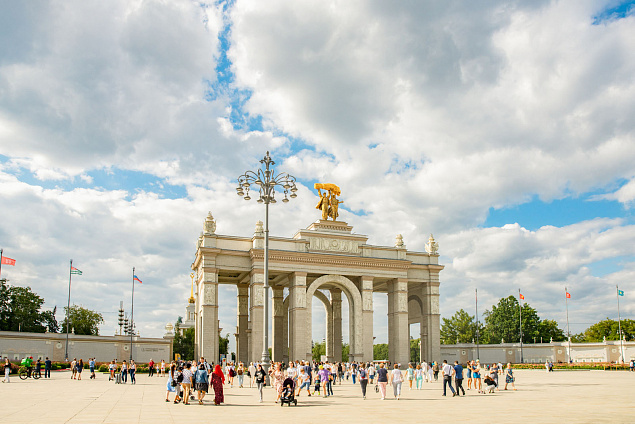On 1 August, Russia's Main Exhibition marks its 82nd anniversary. Ever since it was transferred into the care of the Moscow Government, a large scale restoration programme has been underway. The aim is to carefully restore architectural monuments and open modern cultural, educational and sports spaces. Deputy Mayor Natalya Sergunina notes that over the past years, the exhibition has become one of the main points of attraction for both Moscow residents and tourists.
'We already have over 20 different museum and exhibition platforms active at VDNH. Many cultural heritage sites have undergone comprehensive renovations. These sites include historic pavilions, the Main Entrance Arch, the North and South Entrance and the famous fountains. We have also cleaned up the flower parterre system, the cascade of artificial ponds, the oak and chestnut groves, as well as Michurin's Garden. The total area of the restored historical pavilions reaches almost 50,000 square metres', Ms Sergunina shared.
While doing their work at VDNH, renovation experts have been making most remarkable finds. For instance, an haut-relief titled Festive Leningrad was discovered at Pavilion No. 64 (Optics) in September 2020. The composition had been tucked away behind a false wall and was very well-preserved.
Since August last year, the Exhibition has introduced multiple new cultural, educational and leisure spaces. For example, the Soyuzmultpark centre opened in Pavilion 7 in February 2021. It has 18 multimedia amusement rides inspired by Soviet and Russian cartoons. They use 3D animation and virtual and augmented reality technologies.
Pavilion 38 now houses Business. Technograd: a special centre for business skills and knowledge acquisition. It's part of the Technograd educational cluster at VDNH. Children come to the centre to find out more about promising professions, while young adults use the chance to participate in career training sessions and take a variety of educational courses, and mature adults, to further enhance their professional skills or gain new competencies. There are also exciting and diverse workshops for the whole family. The study programme at Technograd has been co-designed by Moscow's top companies and reflects today's needs of the labour market.
The Floriculture eco-education centre began operating at Pavilion 29 this May. Its interactive exposition is dedicated to nature and modern trends in green space creation. It also has its own cinema lectorium and landscaping school.
Also in May, Pavilion 26 (Transport of the USSR) was converted into a branch of the Moscow Transport Museum. Its visitors can browse a collection of 30 cars, including prototypes of the legendary Russian brand Moskvich, plus about 300 other exhibits. Some of the aforementioned unique prototypes include Moskvich-400, which rolled off the assembly line in the first year after World War II, the 1954 Moskvich-422 model with a wooden body, the millionth Moskvich-408, dating back to 1967, and the GD-1 engine developed by Soviet engineers specially for Formula 1.
Visitors to Pavilions 53 and 54 now get to appreciate the Museum of the Special Purpose Garage of the Russian Federal Guard Service. Among other items, the exposition includes over 50 units of automotive and motorcycle equipment, the oldest of which were produced in 1907.
Pavilion 40 is now the School of Bakers (so far in beta mode). It will become a new educational, cultural and exhibition centre, dedicated to the history and modern state of bread-making. It will be holding workshops, webinars and lectures.
The next grand openings planned at VDNH include the Kazakhstan Pavilion, restored to its original 1954 appearance, and the Centre of National Equestrian Traditions in Pavilions 41 to 43. The Centre's total area will reach 25,400 square metres. The project is co-curated by the Moscow City Government and the Kremlin Riding School.
Behind Pavilion 55, visitors will find a food court with a variety of dishes and high-quality products by top manufacturers. The project's first stage was completed in June.
A historic flower bed in Industry Square, not far from the Vostok Rocket, had been restored by this summer. During the renovations, experts used the flower bed's 1960s photographs as reference. Another new addition during this summer season was the guided tour route titled The Blossoming VDNH, dedicated to the landscaping elements of the exhibition. All interested visitors were able to obtain guidebooks on the local rose and lilac blooming areas.
The entire year of 2021 at VDNH has been dedicated to space travel milestones: the 60th anniversary of Yury Gagarin's space flight and the 50th anniversary of the launch of Salyut, the world's first manned orbital craft. To date, there have been over 100 events under the thematic cultural and educational programmes: online tours, lectures, performances, film screenings and the Space Lessons with Fyodor Yurchikhin, space pilot and Hero of Russia. The World Space Week, among other events, will also bring a lot of fun events.
Incidentally, the famous photograph of Yury Gagarin holding a white dove was returned to its rightful place this spring. This circular panel, 10 metres in diameter, can now be seen at VDNH's Cosmonautics and Aviation Centre, specifically the Space Pavilion (Pavilion 34).
